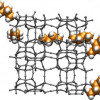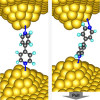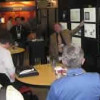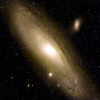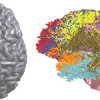News Archive
Reaching for the Stars to Create Music of the Universe
Scientists are quite familiar with what a supernova looks like—when these stars are destroyed in the most massive explosions in the universe, they leave their mark as one of the brightest objects in space, at least for several weeks. Read More »
ESnet Gets a Jump on Implementing DNS Security
The Department of Energy (DOE) has finished implementing Domain Name System Security Extensions (DNSSEC) to its high-performance Energy Sciences Network (ESnet) using a commercial appliance to digitally sign Domain Name System records and manage cryptographic keys. The signed records were published last month, in December 2009, ahead of a mandate from the U.S. Office of Management and Budget (OMB) requiring government networks outside of the .gov domain to do so. Read More »
Worm's Eye View: Molecular Worm Algorithm Navigates Inside Chemical Labyrinth
With the passage of a molecule through the labyrinth of a chemical system being so critical to catalysis and other important chemical processes, computer simulations are frequently used to model potential molecule/labyrinth interactions. In the past, such simulations have been expensive and time-consuming to carry out, but now researchers with the Lawrence Berkeley National Laboratory (Berkeley Lab) have developed a new algorithm that should make future simulations easier and faster to compute, and yield much more accurate results. Read More »
NERSC Helps Researchers Discover a Potential On-Off Switch for Nanoelectronics
Researchers at the Lawrence Berkeley National Laboratory's (Berkeley Lab) Molecular Foundry and Columbia University found that electrical resistance through a molecular junction—a nanometer scale circuit element consisting of a single molecule contacted with gold wires—can be turned on and off by simply pushing and pulling the junction. Experts believe that this newly demonstrated molecular-scale control could be leveraged for future nanoscale electronic devices. Read More »
Workshop Focuses on Use of Manycore and Accelerator-Based Computing for Advancing Science
Online, at conferences and in theory, manycore processors and the use of accelerators such as GPUs and FPGAs are being viewed as the next big revolution in high performance computing (HPC). If they can live up to the potential, these accelerators could someday transform how computational science is performed, providing much more computing power and energy efficiency. Read More »
StarGate Demo at SC09 Shows How to Keep Astrophysics Data Out of Archival "Black Holes"
PORTLAND, Ore.—As both an astrophysicist and director of the San Diego Supercomputer Center (SDSC), Mike Norman understands two common perspectives on archiving massive scientific datasets. During a live demonstration at the SC09 conference of streaming data simulating cosmic structures of the early universe, Norman said that some center directors view their data archives as "black holes," where a wealth of data accumulates and needs to be protected. Read More »
Berkeley Lab's Juan Meza Elected Fellow of AAAS
Juan Meza of the Computational Research Division is one of five researchers from the Lawrence Berkeley National Laboratory elected as Fellows of the American Association for the Advancement of Science (AAAS). Meza was cited "for exemplary service to the federal energy laboratories and professional societies in enhancing research and research participation." Read More »
A Superbright Supernova That’s the First of Its Kind
Berkeley, CA – An extraordinarily bright, extraordinarily long-lasting supernova named SN 2007bi, snagged in a search by a robotic telescope, turns out to be the first example of the kind of stars that first populated the Universe. The superbright supernova occurred in a nearby dwarf galaxy, a kind of galaxy that’s common but has been little studied until now, and the unusual supernova could be the first of many such events soon to be discovered. Read More »
SDSC, UC San Diego, LBNL Team Wins SC09 'Storage Challenge' Award
A research team from the San Diego Supercomputer Center (SDSC) at UC San Diego and the University of California's Lawrence Berkeley National Laboratory (Berkeley Lab) has won the Storage Challenge competition at SC09, the leading international conference on high-performance computing, networking, storage and analysis held Nov. 14-20 in Portland, Oregon. Read More »
First Full-Scale Simulation of Cat-Size Cortex is a Gordon Bell Prize Winner
Portland, Oregon— A team of researchers from the IBM Almaden Research Center and the Lawrence Berkeley National Laboratory won the prestigious Gordon Bell Prize in the special category for their development of innovative techniques that produce new levels of performance on a real application. This year's prize winners were announced Thursday, Nov. 19, 2009 at the awards session of the SC09 conference in Portland. The ACM Gordon Bell Prize annually recognizes the best performance of scientific applications on supercomputers. Read More »







 Instagram
Instagram YouTube
YouTube
